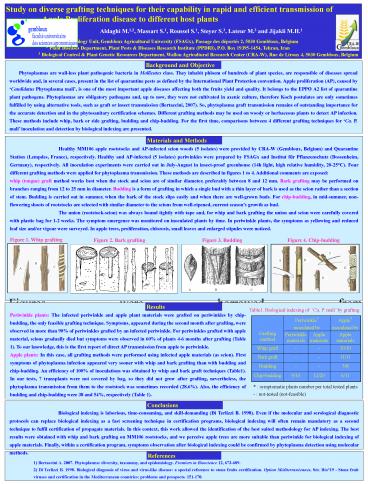Aucun titre de diapositive - PowerPoint PPT Presentation
1 / 1
Title:
Aucun titre de diapositive
Description:
Study on diverse grafting techniques for their capability in rapid and efficient transmission of Apple Proliferation disease to different host plants – PowerPoint PPT presentation
Number of Views:33
Avg rating:3.0/5.0
Title: Aucun titre de diapositive
1
Study on diverse grafting techniques for their
capability in rapid and efficient transmission
of Apple Proliferation disease
to different host plants Aldaghi
M.1,2, Massart S.1, Roussel S.1, Steyer S.3,
Lateur M.3 and Jijakli M.H.1
1 Plant
Pathology Unit, Gembloux Agricultural University
(FSAGx), Passage des déportés 2, 5030 Gembloux,
Belgium
2 Plant
Diseases Department, Plant Pests Diseases
Research Institute (PPDRI), P.O. Box
19395-1454, Tehran, Iran
3 Biological Control Plant Genetic
Resources Department, Wallon Agricultural
Research Center (CRA-W), Rue de Liroux 4, 5030
Gembloux, Belgium
Background and Objective
Phytoplasmas are wall-less plant pathogenic
bacteria in Mollicutes class. They inhabit phloem
of hundreds of plant species, are responsible of
diseases spread worldwide and, in several cases,
present in the list of quarantine pests as
defined by the International Plant Protection
convention. Apple proliferation (AP), caused by
Candidatus Phytoplasma mali, is one of the most
important apple diseases affecting both the
fruits yield and quality. It belongs to the EPPO
A2 list of quarantine plant pathogens.
Phytoplasmas are obligatory pathogens and, up to
now, they were not cultivated in axenic culture,
therefore Koch postulates are only sometimes
fulfilled by using alternative tools, such as
graft or insect transmission (Bertaccini, 2007).
So, phytoplasma graft transmission remains of
outstanding importance for the accurate detection
and in the phytosanitary certification schemes.
Different grafting methods may be used on woody
or herbaceous plants to detect AP infection.
These methods include whip, bark or side
grafting, budding and chip-budding. For the first
time, comparisons between 4 different grafting
techniques for Ca. P. mali inoculation and
detection by biological indexing are presented.
Materials and Methods
Healthy MM106 apple rootstocks and AP-infected
scion woods (5 isolates) were provided by CRA-W
(Gembloux, Belgium) and Quarantine Station
(Lempdes, France), respectively. Healthy and
AP-infected (5 isolates) periwinkles were
prepared by FSAGx and Institut für Pflanzenschutz
(Dossenheim, Germany), respectively. All
inoculation experiments were carried out in
July-August in insect-proof greenhouse (14h
light, high relative humidity, 20-25C). Four
different grafting methods were applied for
phytoplasma transmission. These methods are
described in figures 1 to 4. Additional comments
are exposed whip (tongue) graft method works
best when the stock and scion are of similar
diameter, preferably between 8 and 12 mm. Bark
grafting may be performed on branches ranging
from 12 to 25 mm in diameter. Budding is a form
of grafting in which a single bud with a thin
layer of bark is used as the scion rather than a
section of stem. Budding is carried out in
summer, when the bark of the stock slips easily
and when there are well-grown buds. For
chip-budding, in mid-summer, non-flowering shoots
of rootstocks are selected with similar diameter
to the scions from well-ripened, current seasons
growth as bud. The union (rootstock-scion) was
always bound tightly with tape and, for whip and
bark grafting the union and scion were carefully
covered with plastic bag for 1-2 weeks. The
symptom emergence was monitored on inoculated
plants by time. In periwinkle plants, the
symptoms as yellowing and reduced leaf size
and/or vigour were surveyed. In apple trees,
proliferation, chlorosis, small leaves and
enlarged stipules were noticed.
Figure 1. Whip grafting
Figure 2. Bark grafting
Figure 3. Budding
Figure 4. Chip-budding
Figures were borrowed from www.gartenbauvereine.or
g/texte/merkinfo/m_VeredelungObst.html (figures 1
4), www.ext.nodak.edu/county/cass/horticulture/f
ruit/graft/graft.htm (figure 2), and
http//www.gutenberg.org/files/18189/18189-h/18189
-h.htm (figure 3).
Results
Table1. Biological indexing of Ca. P. mali by
grafting
Periwinkle plants The infected periwinkle and
apple plant materials were grafted on periwinkles
by chip-budding, the only feasible grafting
technique. Symptoms, appeared during the second
month after grafting, were observed in more than
90 of periwinkles grafted by an infected
periwinkle. For periwinkles grafted with apple
material, scions gradually died but symptoms were
observed in 60 of plants 4-6 months after
grafting (Table 1). To our knowledge, this is the
first report of direct AP transmission from apple
to periwinkle. Apple plants In this case, all
grafting methods were performed using infected
apple materials (as scion). First symptoms of
phytoplasma infection appeared very sooner with
whip and bark grafting than with budding and
chip-budding. An efficiency of 100 of
inoculations was obtained by whip and bark graft
techniques (Table1). In our tests, 7 transplants
were not covered by bag, so they did not grow
after grafting, nevertheless, the phytoplasma
transmission from them to the rootstock was
sometimes recorded (28.6). Also, the efficiency
of budding and chip-budding were 38 and 54,
respectively (Table 1).
Grafting method Periwinkle inoculated by Periwinkle inoculated by Apple inoculated by
Grafting method Periwinkle materials Apple materials Apple materials
Whip graft - - 10/10
Bark graft - - 11/11
Budding - - 3/8
Chip-budding 9/10 12/20 6/11
symptomatic plants number per total tested
plants - not-tested (not-feasible)
Conclusions
Biological indexing is laborious,
time-consuming, and skill-demanding (Di Terlizzi
B. 1998). Even if the molecular and serological
diagnostic protocols can replace biological
indexing as a fast screening technique in
certification programs, biological indexing will
often remain mandatory as a second technique to
fulfil certification of propagate materials. In
this context, this work allowed the
identification of the best suited methodology for
AP indexing. The best results were obtained with
whip and bark grafting on MM106 rootstocks, and
we perceive apple trees are more suitable than
periwinkle for biological indexing of apple
materials. Finally, within a certification
program, symptoms observation after biological
indexing could be confirmed by phytoplasma
detection using molecular methods.
References
1) Bertaccini A. 2007. Phytoplasma diversity,
taxonomy, and epidemiology. Frontiers in
Bioscience 12, 673-689. 2) Di Terlizzi B. 1998.
Biological diagnosis of virus and virus-like
disease a special reference to stone fruits
certification. Option Méditerranéennes, Sér.
B/n19 - Stone fruit viruses and certification in
the Mediterranean countries problems and
prospects. 151-170.































